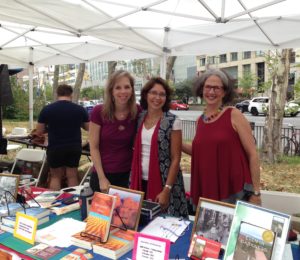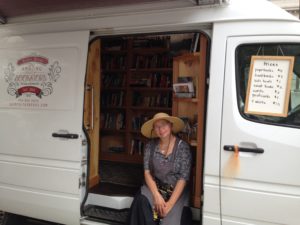It’s such a truism that people aren’t reading any more, and that the physical book is dying. I don’t believe it — partly because the three littlest children I know love books more than almost anything. Their favorite word after a story has been read is “AGAIN!” I can’t believe that they won’t still be holding a book when they are grandmother-aged like me.
That apart, I just returned from the Brooklyn Book Festival, an extravaganza with hundreds of booths, dozens of workshops, and thousands of booklovers. It was like eating ice cream all day. When I approached the Belladonna booth, a young woman told me all about their feminist collective and the importance of women’s voices in literature. I had to blink to be sure I wasn’t talking to my younger self. The other (diverse) women at the booth were all under 30, and seemed just as thrilled as I was to be there.
The Festival was packed, in a good way. I couldn’t find this year’s attendance numbers, but the last count was 30,000. Interspersed among what seemed like miles of booths were a few stages with bleachers or chairs facing them. There was nearly always standing room – and the variety in the crowd really gave me hope. It was nearly always a younger crowd with a few grey heads like mine interspersed rather than the reverse, more genders than we used to count, and lots of shades of human skins and beings. Just seeing that rainbow gives me hope, especially at such a dire time in race relations and murders by police.
For me, the Festival was a landmark – first time I’d ever been to an event like this as an author, not just as a reader. I had the joy of walking around and talking with people who I know love books. Yes, I asked them what they were displaying and why, what their favorites were, how the day was going. But for the first time, I got to say “May I tell you about my book? It’s An Address in Amsterdam, the story of a young Jewish woman who risks her life in the underground during World War II. It’s coming out October 4 from She Writes Press.” Almost everyone smiled and took a post card, usually with some positive comment. Sometimes people who overhead asked for post cards, too!
The whole day was a love fest for people who love books. The booths displayed exquisite letterpress editions, translations of books from a particular moment in France, books that cross the boundaries among the so-called “middle Eastern” nations, every kind of fiction and nonfiction (both pure and hybrid) imaginable. The giants of the publishing industry were absent as far as I could see. Everyone at a booth was from an independent bookstore, or a small or university press, or they were authors and publicists representing books directly. All booklovers – the tribe I’ve belonged to more than any other since I was five years old.
My She Writes Press sisters had several booths, and I hope to be among them next year. Here are Connie Hertzberg Mayo (The Island of Worthy Boys), Anjali Mutter Duva (Faint Promise of Rain) and Barbara Stark Nemon (Even in Darkness). I read all of their books before coming, and can recommend each of them as a delicious experience for historical fiction readers — whether you are in 19th century Boston, 16th century India, or 20th century Europe.

I was also happy to meet Sande Boritz Berger (The Sweetness, a Holocaust era novel which shows the intertwined fates of cousins on either side of the Atlantic) and Barbara Bracht Donsky (Veronica’s Grave, a powerful memoir about growing up without a mother). Melissa Ray was there with a whole booth’s worth of Conjuring Casanova, a romp with a gorgeous cover of Venice. Robert Soares of Booksparks also showed other She Writes books, including mine (!!) and Ginger McKnight-Chavers’ alluring new novel, In the Heart of Texas.
As I looked for a workshop site in neighborhood near the booths, I marveled at the Brooklyn rowhouses, so reminiscent of Amsterdam’s yet in a different color range, a rich, murky reddish brown. Striding toward me were three women: a tall, thin one with curly brown hair and two others wearing STAFF designations. The first was Margaret Atwood, and I felt like a silly teenager gazing at her. That’s a kind of gawking I can get into, as opposed to movie or TV stars who leave me unmoved. I had already seen the line to get into the Atwood talk, and it circled around the block. I instead chose a few events which probably wouldn’t attract the masses, the best being a panel on Inventing History in New Fiction (John Keene, Susan Daitch, Jeremy M. Davies, Christian Lorentzen). Even that obscure subject in the first slot of the day drew a decent crowd.
My favorite “booth” was a van: Saint Rita’s Amazing Traveling Bookstore and Textual Apothecary. It’s stuffed with all kinds of works, and she traveled all the way from Montana to be in Brooklyn. I bought Rilke’s Letters to a Young Poet and a book for my favorite three-year-old, spending the grand sum of $2. But I’ll always remember Rita, and maybe one day, when I’m done promoting my own book, I’ll do just what she does. . . There’s room for a van like hers on the east coast, I’m sure of it. And the market will be there long after I’m gone.

